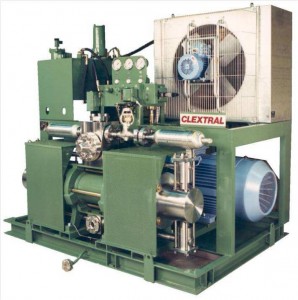
Test and safety pump RIS011PO
GHC (Group of Hydraulic Command) nuclear pumps (RIS011PO/RCV191PO), designed for safety injection circuits, equip close to all the French nuclear power plants (on 900/1300/1450MW) as well nuclear power plants in China, and other plants around the world (Belgium, South Africa, Korea). If an accident occurs, the safety injection circuit lets high pressure borated water into the primary circuit. The pump, located in the Nuclear Auxiliary Building (NAB) is mainly used to hydrotest the reactor cooling system and periodically charge the safety injection system accumulator tanks. It will also provide #1 seal water backup to the reactor coolant pump in the event of station blackout – total loss of electrical power (H3 procedure). The hydrotest pump is a positive displacement pump with opposed plungers piston whose reciprocating rectilinear motion is provided by a hydraulic system: double-acting hydraulic cylinder actuated by an electrically – operated selector valve. Accumulators are installed on the discharge block of the pump, on the water circuit, to absorb pressure peaks. Flow rate and pressure of pumped fluid (water circuit) are proportional to flow rate and pressure of the hydraulic fluid control (oil circuit), minus efficiency losses . The pump unit includes:
- A hydraulic control device
- A charge pump to ensure a minimum pressure on the hydraulic circuit when starting the pump
- An air cooler to cool the hydraulic circuit
- A filtration system
- A tank with a capacity of approx. 120 liters, which receives the circuit’s cooled and filtered hydraulic fluid as well as the fluid drained from the operating machines
- Two accumulators (High and Low Pressure) to limit the pulsations at the pump outlet
These multifunction pumps can be set for different operating modes. For the French, Belgian, Korean, South African and Chinese nuclear nuclear plants, the pump is used to perform three functions:
- Testing the primary circuit’s hydrostatics
Integrated to the injection circuit, the pump increases the primary circuit’s pressure in stages for the hydraulic test.
- Charging the RIS accumulators (except for the 1 300 MW and 1 450 MW plants)
This pump fills and regularly repressurizes the injection accumulators.
- Injection at the reactor coolant pumps seals (GMPP)
Finally, should total loss of electrical power occur (H3 procedure), the pump is used to provide the necessary flow rate to inject the seals as a backup for the unavailable charge pumps. Given its multiple functions, the test pump unit must operate under the following conditions: o Flow rate: from 0 to 6 m3/hour (upto to 9 m3/ hour for 1300 MW and 1 450 MW plants) o Discharge pressures:
- The discharge pressure in make-up function of charging the RIS accumulators is 47 bar (680 psi)
- The test pressure of the primary circuit is 240 bar (3480 psi). The pump is able to achieve this pressure in stages. It must ensure a flow rate of 6 m3/hour and then maintain the pressure level at 240 bar (3480 psi) with no flow.
- When injecting to the primary pump seals, the pump is capable of providing a discharge pressure of 180 bar (2610 psi) at a rate of 6 m3/ hour (up to 9 m3/hour for 1300 MW and 1 450 MW plants).
Qualification
All the pumps of the system are designed and manufactured in compliance with the ASME and RCC-M nuclear standards.

Seismic qualification : tests on vibrating table for the DKM pumps
Pump qualification consists of testing and analyzing (using calculation and comparing with reference data) for the complete pump and its sub-assemblies.
The pump units are designed to ensure the “injection at the seals” function during and after an earthquake. Switching to the “injection at the seals” mode shall also be guaranteed in this situation. Their important role in case of loss of electrical power supplies and the fact that this function can be induced by an earthquake required qualifying the pumps in seismic conditions, using a vibrating table.
